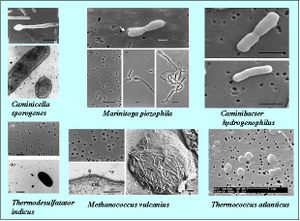Pandoravirus salinus: Difference between revisions
| Line 16: | Line 16: | ||
Large enough to be observe under a light microscope. http://guardianlv.com/2013/07/pandora-virus-is-new-domain-of-life/ | Large enough to be observe under a light microscope. http://guardianlv.com/2013/07/pandora-virus-is-new-domain-of-life/ | ||
We report the isolation of two giant viruses, one off the coast of central Chile, the other from a freshwater pond near Melbourne (Australia), without morphological or genomic resemblance to any previously defined virus families. Their micrometer-sized ovoid particles contain DNA genomes of at least 2.5 and 1.9 megabases, respectively. These viruses are the first members of the proposed “Pandoravirus” genus, http://www.sciencemag.org/content/341/6143/281.short | |||
Interesting features of its structure; how it gains energy (how it replicates, if virus); what important molecules it produces (if any), does it have an interesting life cycle? | Interesting features of its structure; how it gains energy (how it replicates, if virus); what important molecules it produces (if any), does it have an interesting life cycle? | ||
Revision as of 03:56, 20 July 2013
Classification
Domain/Superkingdom/Kingdom; Phylum; Class; Order; Pandoraviridae
Pandoravirus
Description and Significance
Largest known virus found in sediments of Chile coastal area. Under the Baltimore Classification, P. salinus is classified as Group I virus. Give a brief description of the microorganism and explain why you think it is important. How does it relate to the other organisms in its phylum (bacteria and fungi) or group (archaea, virus, protist). Use the following for each reference in text (change number accordingly)--> [1]
Structure, Metabolism, and Life Cycle
Large enough to be observe under a light microscope. http://guardianlv.com/2013/07/pandora-virus-is-new-domain-of-life/
We report the isolation of two giant viruses, one off the coast of central Chile, the other from a freshwater pond near Melbourne (Australia), without morphological or genomic resemblance to any previously defined virus families. Their micrometer-sized ovoid particles contain DNA genomes of at least 2.5 and 1.9 megabases, respectively. These viruses are the first members of the proposed “Pandoravirus” genus, http://www.sciencemag.org/content/341/6143/281.short
Interesting features of its structure; how it gains energy (how it replicates, if virus); what important molecules it produces (if any), does it have an interesting life cycle?
Ecology and Pathogenesis
Natural habitat (soil, water, commensal of humans or animals?)
If relevant, how does this organism cause disease? Human, animal, or plant hosts? Important virulence factors, as well as patient symptoms.
References
[1] EXAMPLE ONLY. REPLACE WITH YOUR REFERENCES. Takai, K., Sugai, A., Itoh, T., and Horikoshi, K. 2000. "Palaeococcus ferrophilus gen. nov., sp. nov., a barophilic, hyperthermophilic archaeon from a deep-sea hydrothermal vent chimney". International Journal of Systematic and Evolutionary Microbiology. 50: 489-500. http://ijs.sgmjournals.org/cgi/reprint/50/2/489
Author
Page authored by Mei Kuen Tang, student of Mandy Brosnahan, Instructor at the University of Minnesota-Twin Cities, MICB 3301/3303: Biology of Microorganisms.

